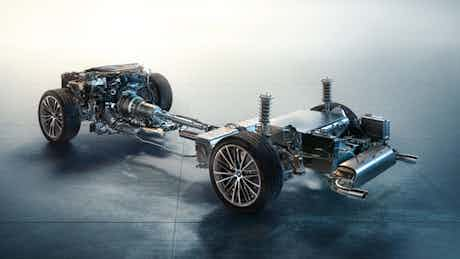What is rear-wheel drive?
February 01, 2023 by carwow staff

Rear-wheel drive cars bring advantages and disadvantages; we explain all
With one or two exceptions, every car on sale today has four wheels. Two, clearly, are at the front of the car, and two at the rear.
Car engineers have three options when choosing what to do with these wheels: they can either make the engine power the front ones, the rear ones, or all four. Here, we’ll look at the pros and cons of rear-wheel drive.
Rear-wheel drive: advantages
It used to be the case that almost all sports and performance cars were rear-wheel drive. This was for a number of reasons, but the general consensus is that rear-wheel drive cars have better, more communicative steering than front-wheel drive models, as the front wheels don’t have to handle power being put to them as well as dealing with steering inputs.
It also tends to be easier to get close to an even 50:50 front/rear weight distribution in a rear-wheel-drive car, as the extra mass of the mechanical components necessary for rear-wheel drive help balance out the significant mass of the engine; again, this leads to better handling.
Rear-wheel-drive cars are also pushed, rather than pulled (as is the case in front-wheel-drive cars) as power is transmitted to them; as with the front wheels only having to deal with steering, this too leads to a more satisfying driving experience, particularly in corners.
Rear-wheel-drive cars can also be better at putting their power down on the road when conditions are dry, as the mass of the car shifts rearward under acceleration, transferring weight to the rear wheels, helping them stick to the road.
Rear-wheel-drive cars don’t suffer from torque steer, either: this is something that can affect front-wheel-drive cars under heavy acceleration, and can see the steering pull to one side as power is applied; torque steer tends to be more of an issue in high-performance front-drive cars.
Rear-wheel drive: disadvantages
Rear-wheel drive cars are often preferred due to the handling characteristics they tend to have, but that’s not to say they’re perfect.
They tend to be more expensive, for one thing, as they require more complex components, such as the long drive shaft that takes power from the engine at the front of the car to the rear wheels.
Rear-wheel-drive cars also have what’s known as a transmission tunnel inside the car. This is a raised hump that runs along the centre of the interior, underneath which sits the drive shaft. Front-wheel-drive cars sometimes have this as well, though, as some are offered with optional four-wheel drive, which necessitates a transmission tunnel which remains present even if four-wheel drive isn’t specified.
Rear-wheel cars also tend to offer less grip in slippery conditions, as there is no engine sitting above them to help push the tyres down onto the road.
Rear-wheel-drive cars can also be more prone to exhibit unpredictable behaviour: if you take a corner too fast in a front-wheel-drive car it is likely to understeer, meaning the car will push wide, relatively predictably. In a rear-wheel-drive car oversteer is more likely, which can see the rear of the car pendulum around, requiring quick driver inputs to correct this – though modern traction-control and stability systems often step in to prevent oversteer, so this is less of an issue than it once was.
Four-wheel-drive cars, meanwhile, are better at putting their power down on the road than rear-drive ones, which is why many modern performance cars now have four-wheel drive, as engines have become so powerful that a rear-drive car may struggle for grip under heavy acceleration, even in dry conditions.
Is rear-wheel drive better than front-wheel drive?
This really is a question of horses for courses. Keen drivers will almost always extoll the handling virtues of rear-drive cars, but that’s not to say there aren’t front-wheel-drive cars that are fantastic to drive – the Honda Civic Type R being just one example.
But the truth is that for most people, most of the time, a front-wheel-drive car will do very well indeed, while also being more predictable to handle in poor conditions, often costing less to buy, and frequently offering more interior and cargo space.
One good example of the debate over which wheels should be driven can be found in the BMW 1 Series: this was historically a rear-wheel-drive with a famed reputation for handling, but research from BMW in 2010 found 80% of 1 Series owners thought their cars were front-wheel drive. Little surprise, then, that when the current 1 Series was launched in 2019, BMW switched it to front-wheel drive for the advantages listed above.
Change cars online with carwow
Looking for an easy way to change your car? Then carwow is the place to go. You can sell your car online for a great price, and get the best deals on a new one. All through our network of trusted dealers and all from the comfort of your home. Tap the button below to get started today.















